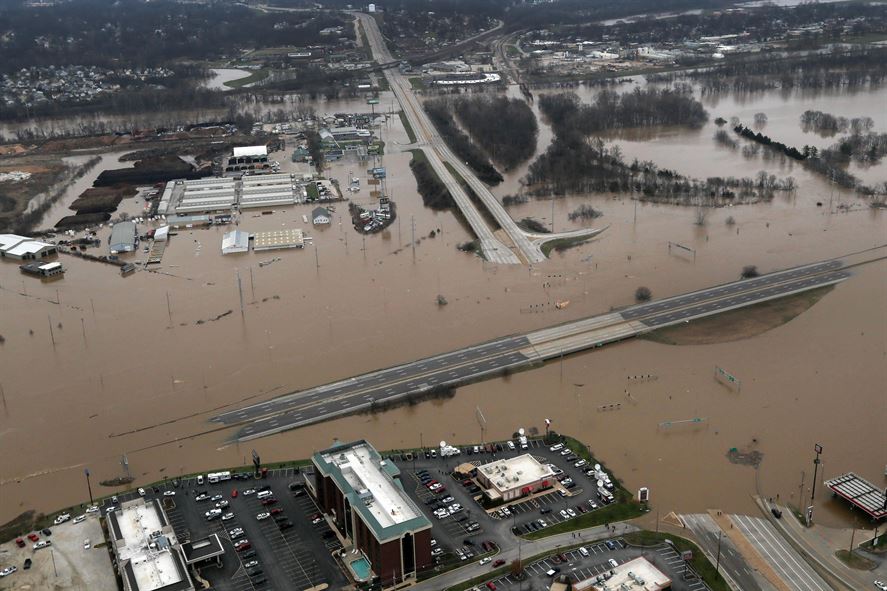This item is a bit over the top, but it does reflect that we are having a maximal event in terms of spring melt all across the continent. Actual real danger is likely to be singular in nature as that demands event stacking typically. Design parameters are pretty good at avoiding predicted maximal risks.
Yet a high tide always opens a window on additional risks. This is a rare high tide in flood conditions that will still likely abate soon enough without further headlines. The big event happens to be Nebraska were it made a mess.
This could still add up to something on the Mississippi.
.
A “perfect storm” of events is now building toward a cascading collapse of mammoth U.S. dams that will displace millions and destroy entire towns
Wednesday, April 10, 2019 by: Isabelle Z.
Wednesday, April 10, 2019 by: Isabelle Z.
Tags: Collapse, dams, disaster, Flooding, infrastructure, midwest, natural disaster, Oroville, safety threat, weather
https://www.naturalnews.com/2019-04-10-perfect-storm-of-events-cascading-collapse-of-dams.html
(Natural News) Dams do their job every day with little fanfare, but when one breaks, the results can be devastating. Imagine entire towns being completely washed away and millions of people losing everything they own and being displaced. It sounds like something out of a big-budget Hollywood doomsday film, but for the millions of people who live near dams, the danger is all too real.
In fact, the National Oceanic and Atmospheric Administration (NOAA) has forecast that two thirds of the 48 contiguous states will be facing a heightened flood risk until May. They predict that there could be “unprecedented” levels of flooding throughout the nation that will put 200 million people in danger.
Some of the areas identified as being at the greatest risk include communities near the Mississippi River, where rain and snow levels have been as much as 200 percent above normal, along with the Great Lakes, the Ohio river basin, and the Tennessee river basin.
NOAA National Water Center Director Ed Clark commented: “The extensive flooding we’ve seen in the past two weeks will continue through May and become more dire and may be exacerbated in the coming weeks as the water flows downstream.”
A combination of rapid snow melt and heavy rainfall inundating the Midwest and plains is fueling the floods, with torrents of rainfall failing to penetrate frozen ground, forcing water to swell rivers and break their banks. As the spring rains continue and snow melts, the flood threat will only be exacerbated.
Flooding has already caused almost $1.5 billion worth of damage in Nebraska, leaving four people dead and one missing. It has damaged hundreds of Midwestern homes so far, and is also being blamed for a handful of deaths in Nebraska and Idaho. Flooding has caused trains to be stopped in Missouri, preventing people and goods from reaching their destinations, and it’s also affecting agriculture significantly, threatening grain stockpiles and killing livestock as tens of thousands of acres get absolutely inundated.
Coastal areas are also being hit by flooding, with NOAA predicting that both the east and west coasts of the nation will experience a greater chance than normal of spring flooding due to high tides.
Nation’s dams not ready to handle all this flooding
Unfortunately, many of America’s dams just aren’t up to the task of handling epic rainfall. Look at what happened with the Oroville Dam in California, which nearly blew out after damage from record-setting rains, threatening to propel a 30-foot wall of water toward Sacramento and everything in its path. The state ultimately had to evacuate 188,000 people in three counties.
Meanwhile, the Fort Peck Dam in Montana is also causing concerns as the upcoming snow melt is coinciding with the Yellowstone Caldera’s seismic activity.
In their Report Card for America’s Infrastructure, the American Society of Civil Engineers said that 15,500 American dams have high-hazard potential, which means that if they fail, it could lead to a catastrophic loss of life. A further 11,882 dams have a “significant hazard potential,” which means a failure might not necessarily cause massive deaths but could cause significant financial losses.
It’s pretty scary to think of how easily a dam can break and how quickly that could wreak massive amounts of havoc and destruction. And what happens when this kind of flooding hits a nuclear reactor? Aging infrastructure and unprecedented rain mean we could be hit by a disaster of epic proportions.

No comments:
Post a Comment